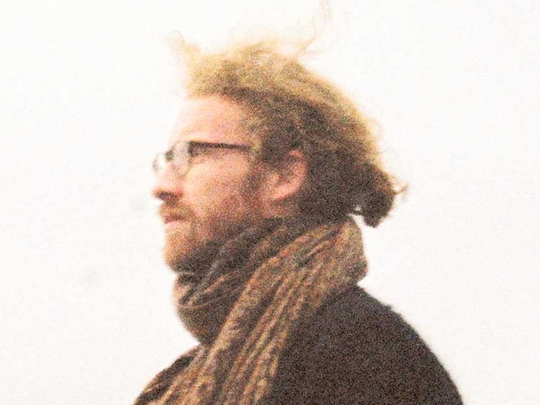
Paris-based American artist Richard Höglund’s first exhibition in the region, “Desert Octave”, features new paintings on linen from his ongoing series “Sea Picture”. For this show, curated by Kamiar Maleki, the artist has used materials such as Sahara sand, bone dust, marble dust, gold, lead, titanium, cadmium, diatomaceous earth, shell, poppy oil and acrylic emulsions to create beautiful textures and a touch of colour in his abstract, mostly white works, and to infuse them with luminosity.
The paintings look like soulful desert landscapes, with a line in the centre marking the horizon, subtly separating the sand from the sky. On each canvas the artist has scribbled some words that are illegible. The artworks are essentially portraits of the human spirit.
Desert Octave III
“My project ‘Sea Pictures’ is a lifelong exploration of universal elements in portraiture, one of which is ‘time’. It is a way for me to leave behind a wake of language. ‘Desert Octave’ comprises eight large and eight small paintings where the language integrated into the picture plane is concerned with trying to imagine a voyage through the desert. I have never been to the desert, so when I thought about the desert it was with the distance that one has having never experienced a place. I believe the romanticism of a place imagined has its own purity, in that it has not been tainted with experience,” Höglund says.
The artist has carefully chosen the size of his canvasses to reflect the human scale. The eight larger paintings are based on the average proportions of a man, and the smaller ones are based on the average size of a man’s head. “I wanted to indicate a man by his index; by his trace rather than his likeness. I wanted to indicate humanity by mark and measure,” he says.
The materials he has used and the writing are also significant parts of the works. “It is important to me to transform a material into something meaningful. When I put Sahara sand in a painting, and you know it is in there, you think about the Sahara, whatever you may know about it. When I put bone dust in a painting, you start to think about mortality; and marble dust reminds you of classicism, and ancient civilisation. These materials individually have meaning, and combined become a kind of conceptual allegory.
“It will always be possible to detect the composition of these ‘Sea Pictures’, and their meaning will be steady and universal as well as fragile and subjective. Time is in the picture, and acts on the picture and its materials the same way it acts on culture and language. The scribbles are actually me writing my thoughts and ideas; but they are lost, and neither I nor anybody else can read them anymore. It is that ephemeral — a kind of trace of humanity. After all language is a trace of humanity because we associate the invention of history with the invention of the written word,” Höglund says.
The number of large and small paintings in this set refers to an octave. It is also connected to poetry, specifically the sonnets of Petrarch, the great Italian renaissance humanist and thinker.
Desert Octave V
“I used the term octave because it is a junction of many of the ideas that went into making the pictures. The octave describes a scale in Western music — a unit but also a range that could theoretically be repeated in infinitely higher or lower pitches. The Octave is both a mirror and an opposition, like the Sublime. When you watch the horizon, you see an infinite thing that appears definite and thus reflects your finite self. The octave is also associated with Hellenic notions of perfection in nature, and how man may relate to the cosmos. When you watch the horizon, light changes and time becomes very strong in your mind. The infinite nature of Nature reminds you of your finitude.
“However, when I developed the title I was thinking more about poetry; the octave as the first eight lines of a Petrarchan sonnet. These eight lines set a stage that would be modified by an event arriving suddenly at the beginning of the closing sextet. I wanted to think about the lines before an event, an unfinished body of work, or work made for a place that I have never seen. I made the octave of my Petrarchan sonnet, but left out the last six lines to convey that this is an incomplete project,” Höglund says.
Jyoti Kalsi is an arts-enthusiast based in Dubai.
“Desert Octave” will run at Custot Gallery Dubai in Alserkal Avenue, Al Quoz, until December 4.












